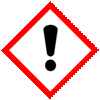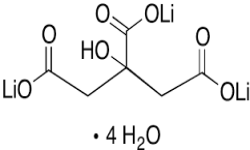CAS Number 6080-58-6 and 919-16-4, Lithium Citrate Anhydrous Tetrahydrate USP BP Ph Eur Grade Manufacturers Exporters







CAS Number 6080-58-6 and 919-16-4, Lithium Citrate Anhydrous Tetrahydrate Manufacturer Exporter
For Properties Specifications of Lithium Citrate Anhydrous Tetrahydrate Click Properties, Specifications of Lithium Citrate Anhydrous Tetrahydrate Manufacturer.
For Uses of Lithium Citrate Anhydrous Tetrahydrate Click Uses of Lithium Citrate Anhydrous Tetrahydrate Manufacturer.
For For SDS MSDS Sheet of Lithium Citrate Anhydrous Tetrahydrate Click SDS Safety Data Sheet MSDS Sheet of Lithium Citrate Anhydrous Tetrahydrate Manufacturer.
The Properties and Specifications of Lithium Citrate Anhydrous Tetrahydrate:
Lithium Citrate USP Grade Specifications
C6H5Li3O7-4H2O -- 281.98
1,2,3-Propanetricarboxylic acid, 2-hydroxy-trilithium salt tetrahydrate.
Trilithium citrate tetrahydrate CAS 6080-58-6
Anhydrous 209.93 CAS 919-16-4
Lithium Citrate contains not less than 98.0 percent and not more than 102.0 percent of C6H5Li3O7, calculated on the anhydrous basis.
Identification:A: When moistened with hydrochloric acid, it imparts an intense crimson color to a nonluminous flame.
B: It responds to the test for Citrate.
pH: between 7.0 and 10.0, in a solution (1 in 20).
Water: Dry it at 150 for 3 hours: it loses between 24.0% and 28.0% of its weight.
Carbonate: Add about 0.5 g to 5 mL of 6 N acetic acid: not more than a slight effervescence is produced.
Heavy metals: the limit is 0.001%.
Lithium Citrate BP Ph Eur Grade Specifications
Ph Eur
C6H5Li3O7,4H2O --- 282.0 --- CAS 6080-58-6
DEFINITION
Trilithium 2-hydroxypropane-1,2,3-tricarboxylate tetrahydrate.
Content: 98.0 per cent to 102.0 per cent (anhydrous substance).
CHARACTERS
Appearance: White or almost white, fine crystalline powder.
Solubility: Freely soluble in water, slightly soluble in ethanol (96 per cent).
IDENTIFICATION
A. When moistened with hydrochloric acid, it gives a red colour to a non-luminous flame.
B. Dilute 3 ml of solution S (see Tests) to 10 ml with water. Add 3 ml of potassium ferriperiodate solution. A white or yellowish-white precipitate is formed.
C. To 1 ml of solution S add 4 ml of water. The solution gives the reaction of citrates.
TESTS
Solution S: Dissolve 10.0 g in carbon dioxide-free water prepared from distilled water and dilute to 100 ml with the same solvent.
Appearance of solution: Solution S is clear and colourless.
Acidity or alkalinity: To 10 ml of solution S add 0.1 ml of PhPh solution. Not more than 0.2 ml of 0.1 M hydrochloric acid or 0.1 M sodium hydroxide is required to change the colour of the indicator.
Readily carbonisable substances: To 0.20 g of the powdered substance to be examined add 10 ml of sulphuric acid and heat in a water-bath at 90 ± 1C for 60 min. Cool rapidly. The solution is not more intensely coloured than reference.
Chlorides: Maximum 100 ppm.
Oxalates: Maximum 300 ppm, calculated as anhydrous oxalate ion.
Sulphates: Maximum 500 ppm.
Heavy metals: Maximum 10 ppm.
Water: 24.0 per cent to 27.0 per cent, determined on 0.100 g.
The Uses of Lithium Citrate Anhydrous Tetrahydrate:
Lithium Citrate is used to treat manic-depressive disorder (bipolar disorder). It works to stabilize the mood and reduce extremes in behavior by restoring the balance of certain natural substances (neurotransmitters) in the brain. It is often used in bipolar disorder treatment.
The MSDS-SDS Hazard Statement of Lithium Citrate Anhydrous Tetrahydrate:
Lithium Citrate (Hydrate) SDS, Safety Data Sheet
MSDS Sheet, Material Safety Data Sheet 12-Jan-22
1. Product Identification
Product Name & Other Names: Lithium Citrate (Hydrate) or Citric salt of lithium.
CAS No.: 6080-58-6
EINECS EC Number: 213-045-8
Molecular Weight: 209.92
Chemical Formula: LiO2CCH2C(OH)(CO2Li)CH2CO2Li (for Anhydrous)
Relevant uses and uses advised against (if any) : Industrial Manufacturing.
2. Hazards Identification
GHS, Globally Harmonized System Classification in accordance with 29 CFR 1910
Hazard Class and Category Code(s), Regulation (EC) No 1272/2008 (CLP)
Serious eye damage/eye irritation Category 2A, H319
Labeling Regulation GHS & EC 1272/2008 (CLP) & GHS
GHS Label Elements  Irritant |
Signal Words: Warning
Hazards statements:
H319: Causes serious eye irritation.
Hazards not otherwise classified (HNOC):
May causes mild skin irritation.
Precautionary statements:
P261: Avoid breathing dust/fume/gas/mist/vapors/spray.
P262: Do not get in eyes, on skin, or on clothing.
P264: Wash … thoroughly after handling.
P280: Wear protective gloves/protective clothing/eye protection/face protection.
P302+P352: IF ON SKIN: Wash with plenty of soap and water.
P305+P351+P338: IF IN EYES: Rinse cautiously with water for several minutes. Remove contact lenses, if present and easy to do. Continue rinsing.
P337+313: If eye irritation persists get medical advice/attention.
3. Composition/Information on Ingredients
Product Name & Other Names: Lithium Citrate (Hydrate) or Citric salt of lithium
CAS No.: 6080-58-6
EINECS EC Number: 213-045-8
4. First Aid Measures
Inhalation: Remove to fresh air. If not breathing, give artificial respiration. If breathing is difficult, give oxygen. Call a physician.
Ingestion: Induce vomiting immediately as directed by medical personnel. Never give anything by mouth to an unconscious person. Call a physician.
Skin Contact: In case of contact, immediately flush skin with plenty of water for at least 15 minutes. Remove contaminated clothing and shoes. Wash clothing before reuse. Call a physician.
Eye Contact: Wash eyes with plenty of water for at least 15 minutes. Call a physician.
5. Fire Fighting Measures
Fire: It is not considered to be a fire hazard.
Fire Extinguishing Media: Use water spray, alcohol-resistant foam, dry chemical, or carbon dioxide. Use means suitable for extinguishing surrounding fire.
Special Information: In the event of a fire, wear full protective clothing and NIOSH-approved self-contained breathing apparatus with full face piece operated in the pressure demand or other positive pressure mode. At high temperatures under fire conditions, it may produce toxic or irritating fumes. Fire-extinguishing work is done from the windward and the suitable fire-extinguishing method according to the surrounding situation is used.
6. Accidental Release Measures
Personal precautions, protective equipment, and emergency procedures: Ventilate area of leak or spill. Avoid breathing dust/fumes/gas/mist/vapors/spray. Use individual protective equipment (waterproof boots, suitable protective clothing, safety glasses, etc.). Do not approach facing the wind.
Environmental precautions: Do not let the product enter drains, soil, or water sources.
Methods and materials used for containment Cleanup procedures and Storage: Contain spilled material. Cover with an inert, non-combustible absorbent material, (e.g. sand, earth, diatomaceous earth, vermiculite). Vacuum or sweep-up and remove to an approved disposal container.
7. Handling and Storage
Precautions for safe handling: Apply according to good manufacturing and industrial hygiene practices. Ensure proper ventilation. In case of insufficient ventilation, wear suitable respiratory equipment. Wash thoroughly after handling. Do not drink, eat, or smoke while handling. Avoid contact with skin, eyes, and clothing. Minimize dust generation. Avoid breathing dust/fumes/gas/mist/vapors/spray. Keep container tightly closed. Avoid ingestion and inhalation. Use individual protective equipment (waterproof boots, suitable protective clothing, safety glasses, etc.).
Conditions for safe storage, including any incompatibilities: Store in cool, dry, and ventilated area away from heat sources and protected from sunlight in tightly closed original container. Keep air contact to a minimum. Store protected from heat, sparks and ignition sources and incompatible materials. Avoid contact with skin and eyes. Avoid inhalation of dust/mist/vapor. Do not store with incompatible materials like strong oxidizing agents, reducing agents, bases.
8. Exposure Controls/Personal Protection
Airborne Exposure Limits: None established.
Ventilation System: A system of local and/or general exhaust is recommended to keep employee exposures as low as possible.
Personal Respirators (NIOSH Approved): For conditions of use where exposure to dust or mist is apparent and engineering controls are not feasible, a particulate respirator (NIOSH type N95 or better filters) may be worn.
Eye Protection: Use chemical safety goggles. Maintain eye wash fountain and quick-drench facilities in work area.
Other Control Measures: Maintain good housekeeping in work area. Handle in accordance with good industrial hygiene and safety practice.
9. Physical and Chemical Properties
Appearance: White crystals.
Odor: Not available.
Odor threshold: Not available.
pH: Not available.
Relative density: Not available.
Melting Point: 112C..
Initial boiling point and boiling range: Not available.
Flash point: Not available.
Auto-ignition temperature: Not available.
Decomposition temperature: Not available.
Upper/lower flammability or explosive limits: Not available.
Vapor pressure: Not available.
Vapor density: Not available.
Evaporation rate: Not available.
Flammability (solid, gas): Not available.
Partition coefficient: n-octanol/water: Not available.
Solubility(ies): Not available.
Viscosity: Not available.
10. Stability and Reactivity
Stability: Stable under ordinary conditions of use and storage.
Hazardous Decomposition Products: Oxides of the lithium and carbon with fumes.
Hazardous Polymerization: Will not occur.
Incompatibilities: Strong oxidizers, reducing agents and bases.
Conditions to Avoid: Incompatibles.
11. Toxicological Information
LD50 Oral - Rat No data available.
Carcinogenicity: No component of this product present at levels greater than or equal to 0.1% is identified as possible or confirmed human carcinogen by IARC, ACGIH, OSHA and NTP.
Mutagenic Effects: Not available.
Developmental Toxicity: Not available.
Reproductive Effects: No information available.
12. Ecological Information
Toxicity to fish: No data available.
Persistence and Degradability: No information available.
Mobility: No information available.
Bioaccumulation/ Accumulation: No information available.
Results of PBT and vPvB assessment: No data available for assessment.
13. Disposal Considerations
Whatever cannot be saved for recovery or recycling should be managed in an appropriate and approved waste disposal facility.
14. Transport Information
DOT USA, TDG Canada & ADR/RID Europe: Not controlled.
IMDG/IMO & IATA: Not controlled.
15. Regulatory Information
USA:
SARA 311/312: See section 2.
16. Other Information
Disclaimer:
**************************
Our company provides this MSDS sheet in good faith but makes no representation as to its comprehensiveness or accuracy. This SDS sheet is intended only as a guide to the appropriate precautionary handling of the material by a properly trained person using this product. The above information has been compiled from various sources and has the possibility of discrepancy and being out-dated information. Individuals receiving the information must exercise their independent judgment and do further search in determining its appropriateness for a particular purpose. In no case shall our company be liable to loss or damages by the product user.
**************************
Anmol Chemicals & Pharmaceuticals Pvt. Ltd. is an off-shoot of Anmol Chemicals Taloja. It is located in MIDC Taloja and it is manufacturing pharmaceutical grades of API, Excepients, Food grade and Reagent grade chemicals. Anmol Chemicals & Pharmaceuticals Pvt. Ltd. is a several decades old group of companies, engaged in manufacturing, supplying, distributing, wholesale supplies for actual users, retail or small pack supplies for research and development chemicals, fine and speciality chemicals, pharmaceutical excipients, mineral fortifiers in chemically pure, Analytical reagent grade, IP BP USP Ph Eur EP JP and other pharmaceutical grade monograph including FCC Food grade chemicals and Nutraceuticals, Mineral Fortifiers at best prices.

Lithium Citrate Anhydrous Tetrahydrate Structure
CAS Number 6080-58-6 and 919-16-4, Lithium Citrate Anhydrous Tetrahydrate Manufacturer Exporter
ANMOL CHEMICALS & PHARMACEUTICALS Pvt. Ltd.
India, USA, Europe, UAE
TELEPHONE: +912223770100
Navi Mumbai, INDIA
e-mail: info(At the rate i.e. @)anmol.org
Copyright. 3-nov-24
We manufacture:

